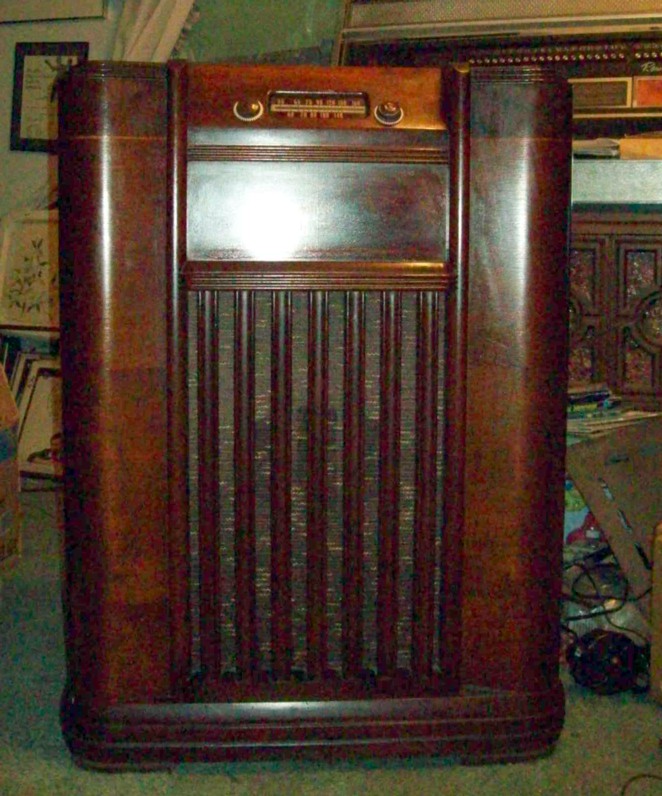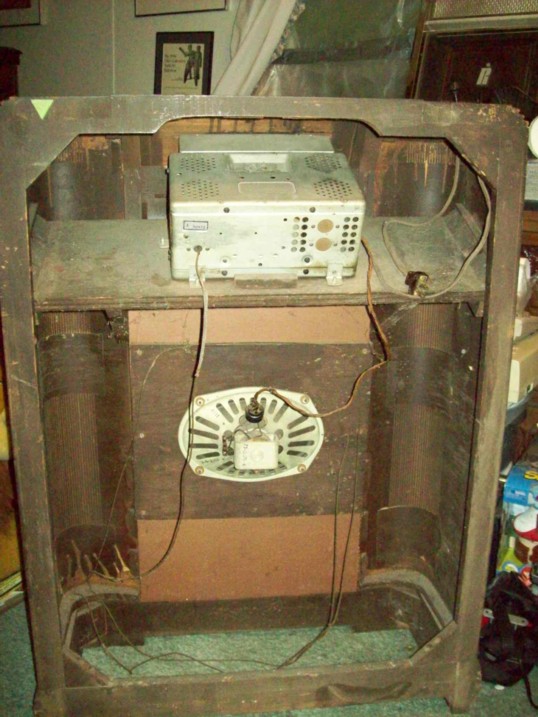Posts: 2,031
Threads: 367
Joined: Jun 2010
City: Dover, OH
After a couple weeks of no responses to my emails and phone calls, I decided to stop in personally at the shop in Barberton to see if the Philco A-361 console was still there. Turns out the shop had changed hands and the Philco was still there and priced $50 lower than it had been in the ad! So, I snagged a nice Philco A-361 console that seems to check out on transformer and even picks up a few stations when brought up on reduced power. Shows plenty of good signs. Cabinet does have a few blemishes, including a crack above the dial that seems caused by poor wood. Speaker looks good except one spot I repaired at the edge of the cone. Actually looked like the paper was simply too thin and wore away over the years. I think with a recap, and a good realignment, this will be a nice set from a unique time in radio history. Chuck: Do you have any paper work on this model I can order?
P.S. The one picture came out dark and grainy, I don't know why. Radio looks better than that!


No matter where you go, there you are.
Posts: 1,532
Threads: 242
Joined: Sep 2012
City: West Bend, Wisconsin
Neat "car radio in a console cabinet" set. I've often wondered if the knobs on these were later used on the 1201's and hippo models after the war? I've never seen a real clear picture of them, but they do appear to be similar.
Greg V.
West Bend, WI
Member WARCI.org
Posts: 2,031
Threads: 367
Joined: Jun 2010
City: Dover, OH
While the knobs look a bit like the ones on the Hippo, they are different animals. There is a plastic knob mounted in front of a metal ring. The ring behind the volume knob is actually a tone control while the one behind the tuning knob is just decoration. I've noticed that the tuning knob has shrunk and warped, causing it to be hard to get off the shaft. Also, the shaft rusted some where it made contact with the plastic while the volume knob and shaft are just fine. Not sure what plastic they used, but it is actually transluscent as light will shine through it!
No matter where you go, there you are.
Posts: 1,532
Threads: 242
Joined: Sep 2012
City: West Bend, Wisconsin
Interesting. Thanks for clearing that up. Looking forward to seeing your progress as you restore this beauty!
Greg V.
West Bend, WI
Member WARCI.org
Posts: 246
Threads: 27
Joined: Aug 2013
City: Petaluma, CA
Be careful when you get around to cleaning the dial lens. The numbering and the lines on the back side will come off very easily. I learned the hard way.
Craig R.
Posts: 2,031
Threads: 367
Joined: Jun 2010
City: Dover, OH
Thanks for the advice. The dial lens looks decent, so I will just let it be.
No matter where you go, there you are.
Posts: 98
Threads: 2
Joined: Jul 2014
City: Eugene, OR
I like it! That's definitely a conversation piece, but it's also a very nice looking radio! Congrats and enjoy the restoration!
Posts: 2,031
Threads: 367
Joined: Jun 2010
City: Dover, OH
More good news with this radio. Tested the tubes and all were very good except the 7B8 tube which read a bit weak. Luckily, I had a better 'Genuine Philco' 7B8 in my stash to swap into the radio. I must say, these loktals are fairly durable tubes overall. Both dial bulbs are blown, but everything else checks out so far. One question I have is cleaning the slug tuners on these units. As I said earlier, it will tune some stations on low power, but it's VERY touchy and I am suspecting dirt and crap in the tuner. Is there a safe way to clean these or should I simply use compressed air to get the worst of the gunk out of the tuning coils and slugs?
No matter where you go, there you are.
Posts: 30
Threads: 4
Joined: Jul 2008
City: Marshall MN
Are these rare? There is one at an antique shop that has been there for years.
Here's another fine mess you have gotten me into. Oliver Norville Hardy.
Posts: 4,808
Threads: 54
Joined: Sep 2008
City: Sandwick, BC, CA
(07-28-2015, 10:01 AM)Scottb Wrote: Are these rare? There is one at an antique shop that has been there for years.
Not really, they seem to turn up on a fairly regular basis, what makes them interesting is the history behind them. There is another similar set that Philco made out of a MoPar car radio, in a chairside or coffee table style cabinet. Both are somewhat on the crude side since Philco was attempting to use up left over Ford and Chrysler car radios by converting them to AC operation.
Regards
Arran
Users browsing this thread: 7 Guest(s)
|
|
Recent Posts
|
|
Philco 40-120C Filament Wiring
|
| Thank you for your replies.
That is the correct schematic and pin out diagram for the rectifier. The resistance acro...bluecap — 11:01 AM |
|
Philco 46-480 Electronic Restoration
|
| Late last night a guy reached out in response to my posting on the Antique Radio Forum and suggested I contact Trust Aut...jrblasde — 11:01 AM |
|
Philco 630csx power cord
|
| Have you opened up that plug? It may be that the third wire is connected to that brass stud on the side of the plug and ...Arran — 02:57 AM |
|
Model 27-84 BUZZ?Humm?
|
| I would have to look at the schematic but it's not uncommon in 1930s AC radios to have the negative of one filter cap co...Arran — 02:46 AM |
|
Model 27-84 BUZZ?Humm?
|
| Hello Bruce,
First all do mean a 37-84b ?
Did you take any before and after pictures ?
is it a buzz like when you touch...radiorich — 01:59 AM |
|
B&K 1077B no video - problem solved
|
| Hello Tim,
Yes, I even check all of my replacement parts when I install them and I too had a capacitor go bad not long a...radiorich — 01:54 AM |
|
B&K 1077B no video
|
| I got back into it tonight. Problem found and resolved! Sometimes it helps to take a break and think things over. It was...TV MAN — 12:40 AM |
|
6TPZ and 5TPO Radio Help
|
| Thank you. I have to take a break from it for about a week. I'll have to do some thinking. I was toying with the idea ...R3Sons — 12:21 AM |
|
Model 27-84 BUZZ?Humm?
|
| Drowning in a overloud buzz/Humm. Have already changed filter caps,bakelite blocks( caps),out of speck resistors,checked...Bruce — 12:17 AM |
|
Philco 630csx power cord
|
| Hello Mike
Here is the Link to the company the place is called Grand Brass lamp parts .
I buy all my Lamp parts plus ...radiorich — 12:00 AM |
|
Who's Online
|
There are currently 4342 online users. [Complete List]
» 2 Member(s) | 4340 Guest(s)
|
|
|

|
 
|





![[-] [-]](https://philcoradio.com/phorum/images/bootbb/collapse.png)


